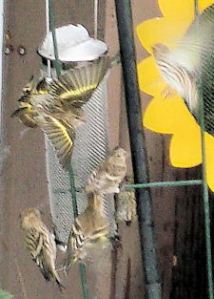Birds Calgary 2010 has several categories you can enter when you submit your counts:
- The Big Year – biggest bird lists for the entire year.
- Big Quarters – biggest bird lists in each of the four quarters of the year.
- Big Day – all the birds observed during a single calendar day.
- Big Sit – all the birds observed during a single calendar day within a 5-metre circle
- Yard List – all the birds seen or heard from within the residence or yard
- Best Bird Find of the Year – all participants are eligible to be the finder of the best bird of the year.
One of the categories you may not be familiar with is NMT Birding.
NMT stands for non-motorized transport. One establishes a fixed home base (e.g., one’s house), and all NMT trips have to start from that home base. All NMT birds have to be seen without using motorized transport at any time from home base to when the bird is seen.
There are two versions of the rules for getting back to home base. Some people think of NMT birding primarily as a way of improving fitness, and being green is a nice byproduct. In that case, motorized transport is permitted on the return journey, but the moment one steps onto motorized transport, no further birds are countable NMT until one reaches home base again.
The other interpretation is for the NMT list to be a green list, and getting fit is a nice byproduct. This interpretation usually requires no motorized transport out or back.
Either interpretation is acceptable for the contest.
In my own case, when I’m on my bike I ride out and back, but when I walk I generally take the bus or C-Train back. This doubles the distance I can reach on foot, because a 30-km round trip walk only gets me to Beaverdam Flats, but a 30-km one way trip (& C-Train back) gets me all the way to Hull’s Woods in Fish Creek park.
A year of great NMT birding has come to an end (only to start anew!) Good exercise, good weather (usually), good birds.
- Totals for 2009 seen (heard): Calgary city, 159 (160); Calgary region, 179 (180).
- Total cycling: 1008 km. Walking: 375 km.
- Longest trip cycling: 95 km. Walking: 35 km.
- Regrets: None.
I’m not sure what qualifies as a best bird, but here are some contenders, in the city unless otherwise specified:
Pacific Loon
Black-crowned Night-heron
White-faced Ibis (region)
Cackling Goose
Broad-winged Hawk
Gyrfalcon
Prairie Falcon (region)
Glaucous Gull
Thayer’s Gull
Sabine’s Gull
Alcid – none (well, at least it was fun looking for them!)
Mountain Chickadee
Magnolia Warbler
Ovenbird
Connecticut Warbler
Harris’s Sparrow
Bill Wilson
Posted by Pat Bumstead









 The Royal Society for the Protection of Birds (RSPB) in the UK has proclaimed October 24 as Feed The Birds Day. It serves as a reminder of all the things we can do to help the birds through the coming winter.
The Royal Society for the Protection of Birds (RSPB) in the UK has proclaimed October 24 as Feed The Birds Day. It serves as a reminder of all the things we can do to help the birds through the coming winter.


